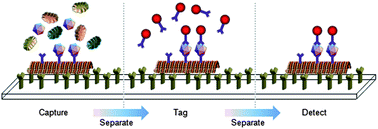Effects of potential environmental interferents on kinesin-powered molecular shuttles
Abstract
Biomolecular motor-powered active transport represents an alternate means for

* Corresponding authors
a Nanobiology Department, Sandia National Laboratories, PO Box 5800, Albuquerque, USA
b
Center for Integrated Nanotechnologies, Sandia National Laboratories, PO Box 5800, MS 1303, Albuquerque, NM, USA
E-mail:
gdbacha@sandia.gov
Fax: +1 (505) 284-7778
Tel: +1 (505) 844-5164
Biomolecular motor-powered active transport represents an alternate means for

 Please wait while we load your content...
Something went wrong. Try again?
Please wait while we load your content...
Something went wrong. Try again?
M. Bachand and G. D. Bachand, Nanoscale, 2012, 4, 3706 DOI: 10.1039/C2NR30570D
To request permission to reproduce material from this article, please go to the Copyright Clearance Center request page.
If you are an author contributing to an RSC publication, you do not need to request permission provided correct acknowledgement is given.
If you are the author of this article, you do not need to request permission to reproduce figures and diagrams provided correct acknowledgement is given. If you want to reproduce the whole article in a third-party publication (excluding your thesis/dissertation for which permission is not required) please go to the Copyright Clearance Center request page.
Read more about how to correctly acknowledge RSC content.
 Fetching data from CrossRef.
Fetching data from CrossRef.
This may take some time to load.
Loading related content
